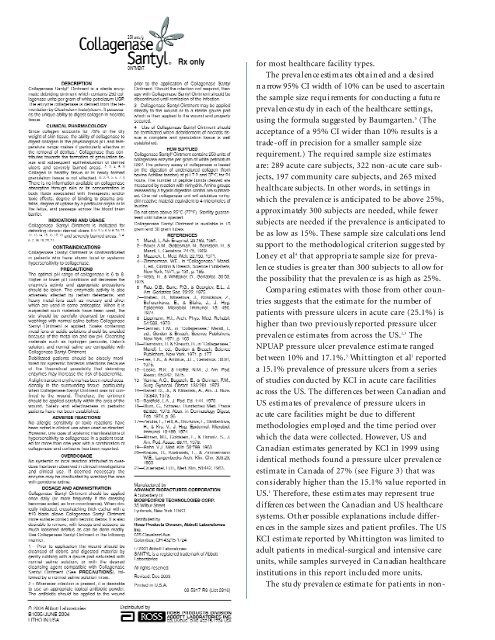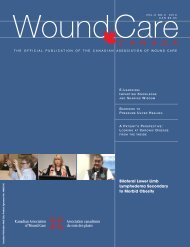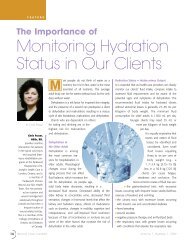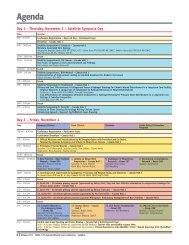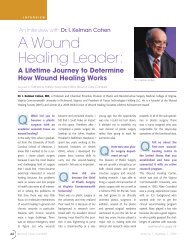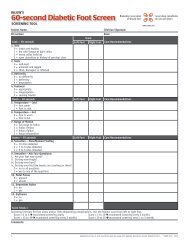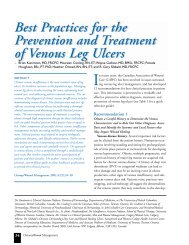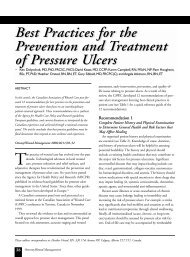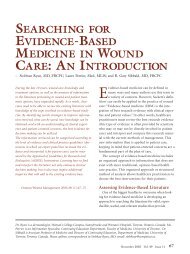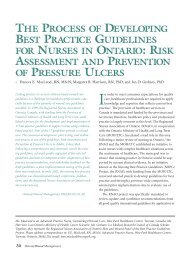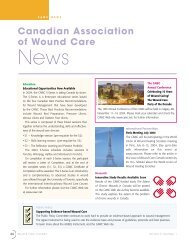M. Gail Woodbury, BScPT, MSc, PhD - Canadian Association of ...
M. Gail Woodbury, BScPT, MSc, PhD - Canadian Association of ...
M. Gail Woodbury, BScPT, MSc, PhD - Canadian Association of ...
You also want an ePaper? Increase the reach of your titles
YUMPU automatically turns print PDFs into web optimized ePapers that Google loves.
for most healthcare fac i l i ty type s .<br />
The preva l en ce esti m a tes obt a i n ed and a de s i red<br />
n a rrow 95% CI width <strong>of</strong> 10% can be used to ascert a i n<br />
the sample size requ i rem ents for con du cting a futu re<br />
preva l en ce stu dy in each <strong>of</strong> the healthcare setti n gs ,<br />
using the formula su gge s ted by Ba u m ga rten . 5 (Th e<br />
accept a n ce <strong>of</strong> a 95% CI wi der than 10% re sults is a<br />
trade - <strong>of</strong> f in prec i s i on for a small er sample size<br />
requ i rem ent.) The requ i red sample size esti m a te s<br />
a re : 289 ac ute care su bj ect s , 322 non - ac ute care su bj<br />
ect s , 197 com mu n i ty care su bj ect s , and 265 mixed<br />
h e a l t h c a re su bj ect s . In other word s , in set ti n gs in<br />
wh i ch the preva l en ce is anti c i p a ted to be above 25%,<br />
a pprox i m a tely 300 su bj ects are needed , while fewer<br />
su bj ects are needed if the preva l en ce is anti c i p a ted to<br />
be as low as 15%. These sample size calculati ons len d<br />
su pport to the met h odo l ogical cri teri on su gge s ted by<br />
Lon ey et al 4 that appropri a te sample size for preval<br />
en ce studies is gre a ter than 300 su bj ects to all ow for<br />
the po s s i bi l i ty that the preva l en ce is as high as 25%.<br />
Com p a ring esti m a tes with those from other co u ntries<br />
su ggests that the esti m a te for the nu m ber <strong>of</strong><br />
p a ti ents with pre s su re ulcers in ac ute care (25.1%) is<br />
h i gh er than two previ o u s ly reported pre s su re ulcer<br />
preva l en ce esti m a tes from ac ross the US. 1 , 3 Th e<br />
N P UAP pre s su re ulcer preva l en ce esti m a te ra n ged<br />
bet ween 10% and 17.1%. 3 Wh i t ti n g ton et al 1 reported<br />
a 15.1% preva l en ce <strong>of</strong> pre s su re ulcers from a seri e s<br />
<strong>of</strong> s tudies con du cted by KCI in ac ute care fac i l i ti e s<br />
ac ross the US. The differen ces bet ween Ca n adian and<br />
US esti m a tes <strong>of</strong> preva l en ce <strong>of</strong> pre s su re ulcers in<br />
ac ute care fac i l i ties might be due to differen t<br />
m et h odo l ogies em p l oye d and the time peri od over<br />
wh i ch the data were co ll ected . However, US and<br />
Ca n adian esti m a tes gen era ted by KCI in 1999 using<br />
i den tical met h ods found a pre s su re ulcer preva l en ce<br />
e s ti m a te in Ca n ada <strong>of</strong> 27% (see Figure 3) that was<br />
con s i dera bly high er than the 15.1% va lue reported in<br />
U S . 1 Th erefore , these esti m a tes may repre s ent tru e<br />
d i f feren ces bet ween the Ca n adian and US healthcare<br />
s ys tem s . Ot h er po s s i ble ex p l a n a ti ons inclu de differen<br />
ces in the sample sizes and pati ent pr<strong>of</strong> i l e s . The US<br />
KCI esti m a te reported by Wh i t ti n g ton was limited to<br />
adult pati ents in med i c a l - su r gical and inten s ive care<br />
u n i t s , while samples su rveyed in Ca n adian healthcare<br />
i n s ti tuti ons in this report inclu ded more units.<br />
The stu dy preva l en ce esti m a te for pati ents in non -


